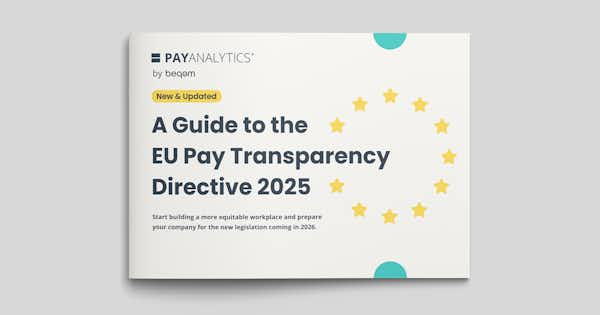A Guide to the EU Pay Transparency Directive 2025 | Download our eGuide for free
Measure

Pay Equity Analysis
Pay equity helps clarify pay structures by identifying drivers of compensation, allowing informed decisions and confident progress.
Overview of all product features
Meet your pay equity goals with the PayAnalytics software. It is designed to get you up and running with minimal setup—supported by video tutorials and digestible documentation.
Pay equity analysis
Reveal the factors influencing pay, make informed decisions.
Pay Transparency
Automate compliance and manage transparency workflows.
Value-based comparison
Compare different jobs under the principle of “equal pay for work of equal value”.
Workforce analytics
Examine and enhance diversity, guide DEI efforts effectively within your organization.
Remediation Actions
Get customized recommendations to close pay gaps, tailored to your needs and budget.
Reports
Essential tools for global compliance and customizable reports for leadership.
Compensation Assistant
Help sustain a bias-free workplace by ensuring good compensation decisions.
Data Management
Refine imported data easily in PayAnalytics with corrections, edits, and additions, ensuring accuracy and visibility.
Job Evaluation
Build objective compensation structures, compare diverse roles based on organizational value.
User Access Controls
Fine-grained access controls, because users have different data access needs.

Are you ready for the EU Pay Transparency Directive? We’ve put together an eGuide to help you learn about the requirements and ensure compliance.
Resources overview
We've put together a knowledge center to help you navigate all things pay equity, DEI, and workforce analytics. This includes articles, downloadable eGuides, podcasts and more.
Guides and E-Books
Explore our how-to guides that give you practical advice on achieving workplace equity. They come in the form of long-form articles and downloadable eGuides.
Articles and blogs
Stay informed on pay equity, transparency, workplace fairness, communication strategies, and current trends.
Local requirements
Stay on top of the changing legal landscape and discover which regulations may apply to you.
The Coffee Talk Podcast
Latest pay equity news in only 8 minutes — every other Friday with Margrét & Henrike.
Customer success stories
Read about how companies have closed the pay gap with PayAnalytics.
Newsletter
Our newsletter covers topics like pay equity, compensation & benefits, DEI, legislation and software updates.

PayAnalytics acquired by beqom
PayAnalytics announced its acquisition by beqom, a leading total compensation and performance management solution provider.
About us
We believe pay is more than a number. Our software is built on over a decade of R&D by award-winning professors, pay equity experts and engineers.
Careers
Join our passionate and highly skilled team. We are pioneers in our field, aiding companies in establishing fair workplaces.
News
The latest company updates, such as events, client news, press releases and so much more.
Brand
Get an overview of our brand, awards, and history. Here you can find downloadable brand assets and photos.
Partnerships
We work with various partners to promote transparency and fairness in pay practices. Explore partnership opportunities.
Consulting services
Tailored pay equity implementation consulting services, designed to complement and enhance the use of our software solutions.
Overview of all product features
Meet your pay equity goals with the PayAnalytics software. It is designed to get you up and running with minimal setup—supported by video tutorials and digestible documentation.
Pay equity analysis
Reveal the factors influencing pay, make informed decisions.
Pay Transparency
Automate compliance and manage transparency workflows.
Value-based comparison
Compare different jobs under the principle of “equal pay for work of equal value”.
Workforce analytics
Examine and enhance diversity, guide DEI efforts effectively within your organization.
Remediation Actions
Get customized recommendations to close pay gaps, tailored to your needs and budget.
Reports
Essential tools for global compliance and customizable reports for leadership.
Compensation Assistant
Help sustain a bias-free workplace by ensuring good compensation decisions.
Data Management
Refine imported data easily in PayAnalytics with corrections, edits, and additions, ensuring accuracy and visibility.
Job Evaluation
Build objective compensation structures, compare diverse roles based on organizational value.
User Access Controls
Fine-grained access controls, because users have different data access needs.
Resources overview
We've put together a knowledge center to help you navigate all things pay equity, DEI, and workforce analytics. This includes articles, downloadable eGuides, podcasts and more.
Guides and E-Books
Explore our how-to guides that give you practical advice on achieving workplace equity. They come in the form of long-form articles and downloadable eGuides.
Articles and blogs
Stay informed on pay equity, transparency, workplace fairness, communication strategies, and current trends.
Local requirements
Stay on top of the changing legal landscape and discover which regulations may apply to you.
The Coffee Talk Podcast
Latest pay equity news in only 8 minutes — every other Friday with Margrét & Henrike.
Customer success stories
Read about how companies have closed the pay gap with PayAnalytics.
Newsletter
Our newsletter covers topics like pay equity, compensation & benefits, DEI, legislation and software updates.
About us
We believe pay is more than a number. Our software is built on over a decade of R&D by award-winning professors, pay equity experts and engineers.
Careers
Join our passionate and highly skilled team. We are pioneers in our field, aiding companies in establishing fair workplaces.
News
The latest company updates, such as events, client news, press releases and so much more.
Brand
Get an overview of our brand, awards, and history. Here you can find downloadable brand assets and photos.
Partnerships
We work with various partners to promote transparency and fairness in pay practices. Explore partnership opportunities.
Consulting services
Tailored pay equity implementation consulting services, designed to complement and enhance the use of our software solutions.

Resources on Pay Equity
Explore the latest thinking on fair compensation, regulatory compliance, and equity analysis. From global pay transparency laws to practical strategies for closing the gap, this collection brings together expert perspectives and actionable insights to help your organization build a fair and equitable pay structure.
- Article
- High performance culture
- Pay equity
Like any investment, pay equity work needs to be protected and future-proofed. Good policies and tools are a start. But to sustain fair pay decades into the future, the organization’s leaders and managers need to be trained on pay equity and pay transparency principles and practices. This article discusses what this training should cover and gives a few considerations for its delivery.
- Article
- Pay equity
On May 16, 2025, Finland’s government working group published draft legislation that would constitute a full transposition of the EU Pay Transparency Directive by amending Finland’s existing Equality Act. This article outlines current pay equity reporting requirements in Finland, then looks at the draft legislation to transpose the EU Directive.
- Article
- Pay equity
If tech tools are well-designed and used effectively, they can not only increase pay equity but also make HR professionals’ work more efficient, cost-effective, and reliable.
- eBook
- Pay equity
Time is ticking to comply with the EU Pay Transparency Directive. Organizations have until June 7th, 2026, to be ready for compliance. Check your readiness status with our checklist and get step-by-step guidance on how to meet the compliance deadline.
- Article
- Pay equity
Uncover the hidden factors behind gender pay gaps—and discover actionable strategies to close them for good.
- Article
- Pay equity
In June of 2025, the Polish parliament amended its existing Labor Code to partially transpose the EU Directive. This follows an earlier transposition attempt in late 2024, which did not pass through parliament. This article gives an overview of the pay equity landscape in Poland as well as more information about the new legislation.
- Article
- Pay equity
In early 2025, Ireland published draft legislation that would enact a partial transposition of the EU Pay Transparency Directive. We take a look at this draft legislation and provide an overview of Ireland’s current pay gap reporting requirements.
- eBook
- Pay equity
How to transpose the EU pay transparency directive into national law? A team of experts, including our own Margrét Bjarnadóttir, provide guidance on how nations might balance effectiveness and ease.
- Guide
- Pay equity
Pay equity falls under the “S” in corporate social responsibility (CSR) and environmental, social and governance (ESG). In Part 1 of this two-part blog, we talked about some best practices for talking about pay equity in CSR/ESG reports and other external communications. Now in Part 2, we’ll focus on some great real-life examples that we can learn from.
- Guide
- Pay equity
As a critical social issue, pay equity falls under the “S” in corporate social responsibility (CSR) and environmental, social and governance (ESG). So how can you best address pay equity in CSR/ESG reports and other external communications? This two-part blog talks about some best practices and provides plenty of examples.
- Article
- Pay equity
While there is no comprehensive federal pay transparency law in the United States, pay transparency laws at the state and city level are becoming increasingly prevalent. These regulations require employers to be more transparent with salary ranges and benefits, and they aim to help promote fairness and equity in the workplace.
- Article
- HR trends
- Pay equity
Fair compensation and pay transparency are effective recruitment tools. But when salaries for new hires are competitive, how can you make sure current employees don’t feel undervalued? This article explains how to balance recruitment and retention using fair pay practices.
Sign up for our newsletter
Our newsletter covers topics like pay equity, compensation & benefits, DEI (diversity, equity and inclusion) and legislation changes as well as news on our company and software updates.











